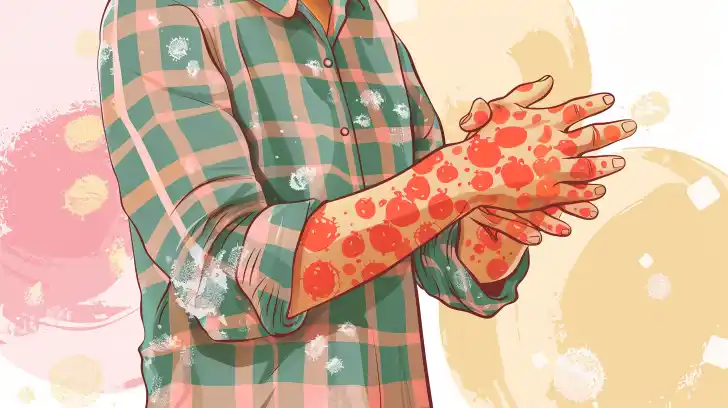Do you see strange patches on your skin? You might have plaque psoriasis. It’s a common skin disease that many people get every year. Let’s talk about what it looks like and how to take care of it.
Plaque psoriasis makes your skin form red, scaly spots. These can itch or hurt sometimes. Knowing these signs helps you understand what’s going on with your skin.
Taking care of your skin is key in managing plaque psoriasis. Using creams and staying away from things that irritate your skin are good steps. Also, light therapy and certain medicines can help calm the symptoms.
Talk to a dermatologist if you think you have this condition. They can give you treatments like topical medications or injectable drugs to lessen the symptoms.
Key Takeaways
- Plaque psoriasis makes your body attack its own skin, leaving red and scaly spots that may itch or hurt.
- This condition comes in many forms, with signs like nail problems, joint pain, and reactions to stress or changes in weather.
- Seeing a doctor is key if you spot thick scales on your elbows or knees. They can find the right treatments for you.
- Mistaking conditions such as eczema for psoriasis happens often. Knowing exactly what you have helps manage it well.
- To handle plaque psoriasis, avoid anything that sets it off. Use medicines or treatments your doctor suggests. You might also need to take care of joint pain from psoriatic arthritis.
Understanding Plaque Psoriasis

Plaque psoriasis makes your immune system attack healthy cells, creating red, scaly patches on your skin. It’s a tough fight against an ongoing skin condition.
How Psoriasis Develops
Psoriasis happens when your immune system acts up. It makes skin cells grow too fast. This causes thick, scaly patches on your skin. It’s an autoimmune disease that messes with how your skin should normally heal.
Things like getting sick, small injuries, or even sunburn can start psoriasis for some people. Different things trigger it in different people — what affects you might not bother someone else at all.
Types of Psoriasis
Let’s tackle psoriasis types and their effects on your skin.
- Plaque Psoriasis: The most common type. You’ll see dry, raised spots with silvery scales. They mainly pop up on the scalp, knees, elbows, and back.
- Guttate Psoriasis: Shows up as small spots shaped like water drops. Mostly found on the trunk, arms, or legs after a strep throat infection. It hits children and young adults harder.
- Inverse Psoriasis: Brings smooth patches of red skin that get worse with rubbing and sweating. Look for it in areas like under breasts or in the groin area.
- Nail Psoriasis: This one goes after fingernails and toenails causing pitting, weird growth patterns, and color changes. Nails might even separate from the nail bed.
- Pustular Psoriasis: Stands out with pus-filled blisters on red and tender skin—often seen rapidly forming on hands or feet.
- Erythrodermic Psoriasis: A rare but intense form that covers large body parts with a peeling rash causing major itching or burning sensations.
Knowing your specific psoriasis type is key to tackling it effectively through proper treatment methods.
The Tell-Tale Signs of Plaque Psoriasis

Plaque psoriasis causes red patches and silvery scales on your skin. These can be painful or itchy.
The Body Parts Involved
Psoriasis can make your skin dry and raise up in areas. You might see silver-white scales on these spots. They often pop up on your scalp, elbows, knees, and lower back. These patches look different from the rest of your skin.
Your fingernails and toenails can also get affected by psoriasis. This can lead to tiny dents, color changes, and nails that don’t grow right. Knowing about these issues helps you spot psoriasis early for treatment.
Shape and Distribution of Lesions
Plaque psoriasis lesions often show up on your scalp, knees, elbows, and lower back. These spots are dry and raised with a red color. They might cover big or small areas of your body.
Each person sees these lesions spread in different ways, but they usually have clear edges.
Your skin around these lesions can crack and bleed if it gets too dry. Sometimes, the lesions group together, making bigger areas get psoriasis. This condition hits everyone’s body differently.
Scales on the Rash and Flaking
Dry, raised patches with scales are signs of plaque psoriasis. These scales can be thick and whitish-silver, sitting on red, inflamed skin that might crack and bleed if too dry. Keeping the skin moisturized helps reduce flaking.
The flaking is similar to severe dandruff and falls off in small pieces. It’s not only about looks; it causes itching and discomfort too. Over-the-counter ointments and moisturizers can offer relief.
For tougher cases, a healthcare professional might suggest topical corticosteroids or phototherapy.
Nail Pitting
Nail pitting often happens if you have plaque psoriasis. You’ll see tiny dents on your fingernails or toenails. This is because psoriasis messes up how nail cells grow. Your nails might also change shape and color.
If your nails start to look odd, it’s probably nail psoriasis. Catching this early lets you treat it right away with special creams and light therapies that help your skin and nails stay healthy.
Triggers
Knowing your psoriasis triggers helps you manage flare-ups, making your skin feel and look better.
- Infections – Getting sick with bacterial or viral infections can wake up your immune system, which might bring on a psoriasis outbreak.
- Skin injuries – Things like cuts, bruises, or sunburns can lead to new or worse psoriasis spots.
- Stress – When stress levels go up, your body’s defense drops, often causing more flare-ups.
- Medications – Some medicines, including beta-blockers and lithium, are known to set off psoriasis.
- Smoking and Alcohol – Using tobacco and drinking a lot of alcohol can make outbreaks happen more often and more severely.
- Weather changes – Psoriasis usually gets worse in cold, dry weather but may get better when it’s warm and sunny.
- Diet – Certain foods might trigger symptoms for some people; this is different for everyone.
It’s crucial to figure out what worsens your symptoms. Making small changes in how you live can help control these triggers effectively.
Joint Pain
If you have plaque psoriasis, joint pain might be a problem for you. Up to 30% of people with this skin condition get psoriatic arthritis. That means your joints can feel stiff and hurt a lot.
This arthritis doesn’t pick favorites—it can hit your hands, feet, neck, or lower back.
Jumping on treatment early is key. Your doctor might suggest medicines like NSAIDs (stuff like ibuprofen) or drugs that change how your immune system works to fight this arthritis.
If your joints start to feel stiff or sore, it’s important to chat with your doctor—don’t wait around!
Misconceptions: Conditions That Can Look Like Psoriasis but Aren’t
To tell psoriasis apart from similar skin issues, you need to pay close attention.
Eczema
Eczema makes your skin red, inflamed, and itchy. There are different types of eczema that affect you in unique ways. Seborrheic dermatitis shows up as flaky scales on your scalp and oily parts of your face.
If you touch allergens or irritants, irritant or allergic contact dermatitis can make your skin turn red and itch.
To manage eczema, stay away from things that trigger it. Use hydrocortisone creams to calm the irritation. Each eczema type needs its own way of handling to reduce symptoms like itching and swelling.
Seborrheic Dermatitis
Seborrheic dermatitis hits your scalp and oily face spots hard. It shows up as red patches with flaky scales. This skin problem is a type of eczema, but it attacks different body areas.
You might confuse seborrheic dermatitis with just dandruff because of where it appears and how it looks. Yet, this issue can bother you more and sticks around without right treatments.
Staying clean and using special topical treatments can control its effects and make you feel better.
Parapsoriasis
Parapsoriasis shows up as pink patches with thin scales, different from the thicker, red ones found in plaque psoriasis. Plaque psoriasis usually appears on knees, elbows, and scalp but parapsoriasis doesn’t follow a specific pattern on the body.
It’s vital for seniors to watch out for these signs. This condition can turn into cutaneous T-cell lymphoma, a skin cancer type, in a few cases.
Keeping an eye on your skin changes is essential. Catching it early helps manage parapsoriasis well and stops it from getting worse.
When to Consult a Doctor
Visit a doctor quickly if your psoriasis gets worse or spreads, causing pain. If skin changes bother you or treatments don’t work, it’s time for help. Psoriasis can affect your mental health, leading to feelings like anxiety and depression.
Your doctor might suggest different treatments like methotrexate, cyclosporine, or injectable medications to better manage symptoms.
Painful joints or trouble moving could mean psoriatic arthritis. This needs fast action for the best treatment results. Dealing with psoriasis often means working with a team to tackle both the skin issues and related health problems.
Conclusion
Seeing raised patches, flaky scales, and feeling joint pain? Your skin is telling you something important. Act fast to control these symptoms. Seeing a doctor could be the key to better skin health.
For those seeking a life free from glasses or contacts, explore our options for affordable monthly laser eye surgery.
FAQs
1. What are common signs of plaque psoriasis?
Common signs include itchy skin, red patches covered with silvery scales, and sometimes joint inflammation. You might also notice skin rashes that don’t go away.
2. Can scalp problems indicate plaque psoriasis?
Yes, scalp issues like severe dandruff or scaly patches can be symptoms of scalp psoriasis, a form of this condition.
3. Is there a link between genetics and plaque psoriasis?
Indeed, there is! If your family has a history of the disease, you’re more likely to develop it due to genetic predisposition.
4. How does one treat plaque psoriasis?
Treatments vary but can include creams, gels—like coal tar—and medications such as nonsteroidal anti-inflammatory drugs (NSAIDs). Severe cases may need stronger options like disease-modifying antirheumatic drugs.
5. Can lifestyle factors impact plaque psoriasis?
Absolutely! Stress management is crucial since social stress can worsen symptoms. Also maintaining good hygiene helps manage flare-ups effectively.
6. Are other health issues associated with plaque psoriasis?
Yes – people with this condition often have higher chances of autoimmune diseases like rheumatoid arthritis and Crohn’s disease; monitoring overall health is key.





